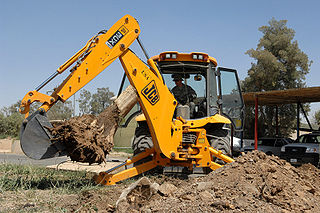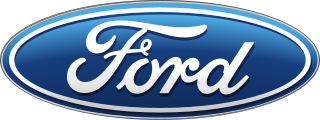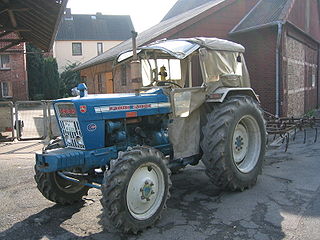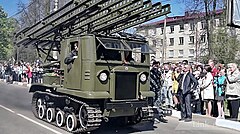This article does not cite any sources .(February 2012) (Learn how and when to remove this template message) |
The Ford GT75 is a diesel lawn tractor manufactured by Ford. a 48-inch mowing deck, and is belt-driven with six rotating blades.
This article does not cite any sources .(February 2012) (Learn how and when to remove this template message) |
The Ford GT75 is a diesel lawn tractor manufactured by Ford. a 48-inch mowing deck, and is belt-driven with six rotating blades.
| This vehicle-related article is a stub. You can help Wikipedia by expanding it. |

A tractor is an engineering vehicle specifically designed to deliver a high tractive effort at slow speeds, for the purposes of hauling a trailer or machinery such as that used in agriculture or construction. Most commonly, the term is used to describe a farm vehicle that provides the power and traction to mechanize agricultural tasks, especially tillage, but nowadays a great variety of tasks. Agricultural implements may be towed behind or mounted on the tractor, and the tractor may also provide a source of power if the implement is mechanised.

The Ford Model T is an automobile produced by Ford Motor Company from October 1, 1908, to May 26, 1927. It is generally regarded as the first affordable automobile, which made car travel available to middle-class Americans. The relatively low price was partly the result of Ford's efficient fabrication, including assembly line production instead of individual hand crafting.

A backhoe — also called rear actor or back actor — is a type of excavating equipment, or digger, consisting of a digging bucket on the end of a two-part articulated arm. It is typically mounted on the back of a tractor or front loader, the latter forming a "backhoe loader". The section of the arm closest to the vehicle is known as the boom, while the section that carries the bucket is known as the dipper, both terms derived from steam shovels. The boom is generally attached to the vehicle through a pivot known as the king-post, which allows the arm to pivot left and right, usually through a total of 180 to 200 degrees.

The Highland Park Ford Plant is a former Ford Motor Company factory located at 91 Manchester Avenue in Highland Park, Michigan. It was the second American production facility for the Model T automobile and the first factory in history to assemble cars on a moving assembly line. It became a National Historic Landmark in 1978.

The International Harvester Company was an American manufacturer formed from the 1902 merger of McCormick Harvesting Machine Company and Deering Harvester Company. The business lines of the company included agricultural equipment, automobiles, commercial trucks, lawn and garden products, household equipment, and other entities. Along with the Farmall and Cub Cadet tractors, International is also known for the Scout and Travelall vehicle nameplates.

Fordson was a brand name of tractors and trucks. It was used on a range of mass-produced general-purpose tractors manufactured by Henry Ford & Son Inc from 1917 to 1920, by Ford Motor Company (U.S.) and Ford Motor Company Ltd (U.K.) from 1920 to 1928, and by Ford Motor Company Ltd (U.K.) from 1929 to 1964. The latter also later built trucks and vans under the Fordson brand.

The Ford flathead V8 is a V8 engine with a flat cylinder head designed by the Ford Motor Company and built by Ford and various licensees. During the engine's first decade of production, when overhead-valve engines were used by only a small minority of makes, it was usually known simply as the Ford V‑8, and the first car model in which it was installed, the Model 18, was often called simply the "Ford V‑8", after its new engine. Although the V8 configuration was not new when the Ford V8 was introduced in 1932, the latter was a market first in the respect that it made an 8-cylinder affordable and a V engine affordable to the emerging mass market consumer for the first time. It was the first independently designed and built V8 engine produced by Ford for mass production, and it ranks as one of the company's most important developments. A fascination with ever-more-powerful engines was perhaps the most salient aspect of the American car and truck market for a half century, from 1923 until 1973. The engine was intended to be used for big passenger cars and trucks; it was installed in such until 1953, making the engine's 21-year production run for the U.S. consumer market longer than the 19-year run of the Ford Model T engine for that market. The engine was on Ward's list of the 10 best engines of the 20th century. It was a staple of hot rodders in the 1950s, and it remains famous in the classic car hobbies even today, despite the huge variety of other popular V8s that followed.

The Ferguson-Brown Company was a British agricultural machinery company formed by Harry Ferguson in partnership with David Brown.

Henry George "Harry" Ferguson was an Irish-born British mechanic and inventor who is noted for his role in the development of the modern agricultural tractor and its three point linkage system, for being the first person in Ireland to build and fly his own aeroplane, and for developing the first four-wheel drive Formula One car, the Ferguson P99.

Ford of Britain is a British wholly owned subsidiary of Blue Oval Holdings, itself a subsidiary of Ford International Capital LLC, which is a subsidiary of Ford Motor Company. Its business started in 1909 and has its registered office in Brentwood, Essex. It adopted the name of Ford of Britain in 1960.

The Ford N-series tractors were a line of farm tractors produced by Ford between 1939 and 1952, spanning the 9N, 2N, and 8N models.
New Holland is a global brand of agricultural machinery produced by CNH Industrial. New Holland agricultural products include tractors, combine harvesters, balers, forage harvesters, self-propelled sprayers, haying tools, seeding equipment, hobby tractors, utility vehicles and implements, and grape harvesters.

The Ford Transcontinental is a heavy goods vehicle tractor and rigid unit that was manufactured between 1975 and 1984 by Ford Europe in the Netherlands and Britain. A total of 8735 units were produced, 8231 in Amsterdam and another 504 at the Foden VAP in Sandbach, Cheshire UK.

Tractors in India is a major industry and significant contributor to its agriculture output gains.
Truck classifications are typically based upon the maximum loaded weight of the truck, typically using the gross vehicle weight rating (GVWR) and sometimes also the gross trailer weight rating (GTWR), and can vary among jurisdictions.

The Ford 5000 is a blue and white tractor that was produced from 1964 to 1979 by Ford. It was a mid-range tractor, suitable for European farms. The North American versions was slightly different and was named the Ford Major. A similar model, the Ford 3000 was introduced in the spring of 1965.

The Ford 3-Ton M1918 was one of the first tank designs by the U.S. It was a small two-man, one-gun tank. It was armed with a M1919 Browning machine gun and could reach a maximum speed of 8 mph. The 3-Ton had a 17-gallon tank that gave it a maximum range of 34 miles.

The T-1 tractor was a project developed by the Romanian Army during World War II. A total of 1,000 were ordered. It was designed to tow a Romanian 75 mm gun. After five prototypes were produced, the project was canceled due to the lack of priority.

Henry Ford & Son Ltd is the Irish subsidiary of the United States-based automaker Ford Motor Company. With an assembly plant for motor vehicles, it was part of the automotive industry in Ireland.